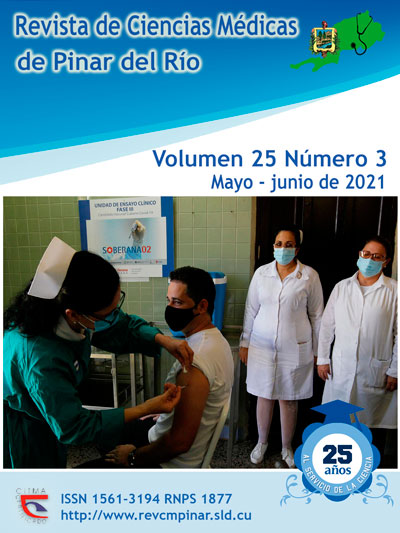Clear cell type renal carcinoma with sarcomatoid differentiation
Keywords:
CARCINOMA, KIDNEY NEOPLASMS, CELLS, BIOPSY/PATHOLOGY, KIDNEY.Abstract
Introduction: clear cell type renal carcinoma with sarcomatoid differentiation is a rare tumor.
Objective: to report the diagnosis of a clear cell type renal carcinoma with sarcomatoid differentiation.
Case report: a 59-year-old, heavy smoker male patient, attending to the doctor’s office presenting lumbar pain and hematuria. The imaging studies showed a tumor lesion in the right kidney. Surgical treatment was indicated and the histopathological study reported a clear cell type renal carcinoma with sarcomatoid differentiation. The patient underwent chemotherapy and at present he maintains oncological follow-up.
Conclusions: clear cell type renal carcinoma with sarcomatoid differentiation is rare. The treatment of election is surgery and pathology report confirms the true diagnosis.
Downloads
References
1. Queipo FJ, Panizo A, Sola JJ, Beorlegui C, Velis JM, Dolezal P, et al. Carcinomas renales con rasgos sarcomatoides y rabdoides: estudio clínico-patológico de 74 casos. Anales Sis San Navarra [Internet]. 2018 [citado 21/11/2020]; 41(2): 191-199. Disponible en: http://scielo.isciii.es/scielo.php?script=sci_arttext&pid=S1137-66272018000200191
2. Cortés-Vázquez YD, Cortés-Vázquez AR, Priego-Niño A, Fernández-Vivar E, Silva-Bravo F, Gutiérrez-Quiróz C. Carcinoma renal de células claras con patrón sarcomatoide asociado a metástasis gingival. Reporte de caso y revisión de la literatura. Cir Cir [Internet]. 2020 [citado 21/11/2020]; 88(s1): 54-58. Disponible en: https://www.cirugiaycirujanos.com/files/circir_20_88_supl_1_054-058.pdf
3. Díaz Goizueta FJ. Factores que influyen en la supervivencia a largo plazo en el cáncer renal de células claras después de la nefrectomía radical [tesis doctoral]. Salamanca: Universidad de salamanca; 2018 [citado 21/11/2020]. Disponible en: https://gredos.usal.es/bitstream/handle/10366/140314/DC_DiazGoizuetaFJ_SupervivenciaC%C3%A1ncerRenalC%C3%A9lulasClaras.pdf?sequence=1&isAllowed=y
4. Miranda Utrera NR. Análisis molecular del carcinoma renal de células claras. Identificación de un perfil de micrornas como factor pronóstico en pacientes en estadio I-II [tesis doctoral]. Madrid: Universidad Complutense de Madrid; 2017 [citado 21/11/2020]. Disponible en: https://eprints.ucm.es/41377/
5. Malouf GG, Flippot R, Dong Y, Dinatale RG, Chen YB, Su X, et al. Molecular characterization of sarcomatoid clear cell renal cell carcinoma unveils new candidate oncogenic drivers. Rev Scientific Reports [Internet]. 2020 [citado 21/11/2020]; 10(701): [aprox. 10 p.]. Disponible en: https://www.nature.com/articles/s41598-020-57534-5
6. Yu W, Wang X, Wang Y, Jiang Y, Zhang W, Shi H, et al. A novel highly frequent single nucleotide polymorphism site of cadherin 23 in clear cell renal cell carcinoma with sarcomatoid differentiation based on whole exome sequencing. Rev Oncology Reports [Internet]. 2020 [citado 21/11/2020]; 44(2): 735-746. Disponible en: https://pubmed.ncbi.nlm.nih.gov/32468012/
7. Boustany J, Abdessater M, El Hachem C, El Khoury Z, El Khoury W, El Khoury R. Recurrent metastatic clear cell renal carcinoma with sarcomatoid dedifferentiation treated with surgery and Cabozantinib. Rev Oncotarget [Internet]. 2020 [citado 21/11/2020]; 11(20): 1922-1928. Disponible en: https://www.ncbi.nlm.nih.gov/pmc/articles/PMC7244017/
8. Bi M, Zhao S, Said JW, Merino MJ, Adeniran AJ, Xie Z, et al. Genomic characterization of sarcomatoid transformation in clear cell renal cell carcinoma. Rev PNAS [Internet]. 2016 [citado 21/11/2020]; 113(8): 2170-2175. Disponible en: https://www.pnas.org/content/pnas/113/8/2170.full.pdf
9. Massari F, Di-Nunno V, Gatto L, Santoni M, Schiavina R, Cosmai L, et al. Should Carmena really change our attitude towards cytoreductive nephrectomy in metastatic renal cell carcinoma? A systematic review and meta-analysis evaluating cytoreductive nephrectomy in the era of targeted therapy. Targeted Oncology [Internet]. 2018 [citado 21/11/2020]; 13(6): 705-714. Disponible en: https://pubmed.ncbi.nlm.nih.gov/30324488/
10. Alevizakos M, Gaitanidis A, Nasioudis D, Msaouel P, Appleman LJ. Sarcomatoid renal cell carcinoma: population-based study of 879 patients. Rev Clinical Genitourinary Cancer [Internet]. 2018 [citado 21/11/2020]; 17(3): 447-453. Disponible en: https://www.sciencedirect.com/science/article/abs/pii/S155876731930014X
11. El Mouallem N, SC Smith, AK Paul. Sarcomatoid renal cell carcinoma: Biology and treatment advances. Rev Urologic Oncology: Seminars and Original Investigations [Internet]. 2019 [citado 21/11/2020]; 36(6): 265-271. Disponible en: https://www.sciencedirect.com/science/article/abs/pii/S1078143917306257
12. Williamson SR. Renal cell carcinomas with a mesenchymal stromal component: what do we know so far? Rev Pathology [Internet]. 2019 [citado 21/11/2020]; 51(5): 453-462. Disponible en: https://www.sciencedirect.com/science/article/abs/pii/S0031302519300054
Downloads
Published
How to Cite
Issue
Section
License
Authors who have publications with this journal agree to the following terms: Authors will retain their copyrights and grant the journal the right of first publication of their work, which will be publication of their work, which will be simultaneously subject to the Creative Commons Attribution License (CC-BY-NC 4.0) that allows third parties to share the work as long as its author and first publication in this journal are indicated.
Authors may adopt other non-exclusive license agreements for distribution of the published version of the work (e.g.: deposit it in an institutional telematic archive or publish it in a volume). Likewise, and according to the recommendations of the Medical Sciences Editorial (ECIMED), authors must declare in each article their contribution according to the CRediT taxonomy (contributor roles). This taxonomy includes 14 roles, which can be used to represent the tasks typically performed by contributors in scientific academic production. It should be consulted in monograph) whenever initial publication in this journal is indicated. Authors are allowed and encouraged to disseminate their work through the Internet (e.g., in institutional telematic archives or on their web page) before and during the submission process, which may produce interesting exchanges and increase citations of the published work. (See The effect of open access). https://casrai.org/credit/



